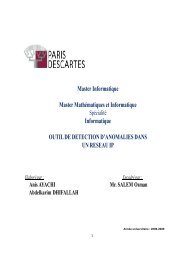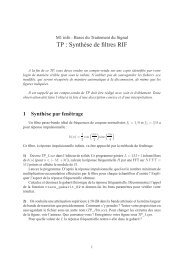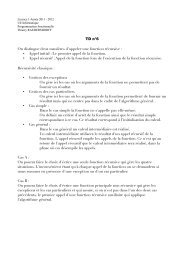Th`ese de Doctorat de l'université Paris VI Pierre et Marie Curie Mlle ...
Th`ese de Doctorat de l'université Paris VI Pierre et Marie Curie Mlle ...
Th`ese de Doctorat de l'université Paris VI Pierre et Marie Curie Mlle ...
You also want an ePaper? Increase the reach of your titles
YUMPU automatically turns print PDFs into web optimized ePapers that Google loves.
we <strong>de</strong>scribe in <strong>de</strong>tails the I<strong>de</strong>al Bandwidth Allocation (IBA) algorithm that needs the<br />
knowledge of arrival time, duration and offered load of all the connections offered to the<br />
n<strong>et</strong>work.<br />
6.1 Problem Statement<br />
Hereafter, we recall the n<strong>et</strong>work mo<strong>de</strong>l <strong>de</strong>scribed in Section 4.1.<br />
L<strong>et</strong> us mo<strong>de</strong>l the n<strong>et</strong>work as a directed graph G =(N,L) where no<strong>de</strong>s represent routers<br />
and directed arcs represent links. Each link l ∈ L has associated the capacity Cl. As<strong>et</strong>of<br />
K connections is offered to the n<strong>et</strong>work. Each connection is represented by the notation<br />
(sk,dk,srk,r mink), for k =1,...,K,wheresk, dk, srk and r mink represent respectively<br />
the connections source no<strong>de</strong>, <strong>de</strong>stination no<strong>de</strong>, subscribed rate and the minimum band-<br />
width the application requires to work correctly. L<strong>et</strong> a l k be the routing matrix: al k =1<br />
if connection k is routed on link l, a l k<br />
= 0 otherwise. We assume that a communication<br />
b<strong>et</strong>ween a user pair is established by creating a session involving a path that remains fixed<br />
throughout the user pair conversation duration. The session path choice m<strong>et</strong>hod (i.e., the<br />
routing algorithm) is not consi<strong>de</strong>red in this thesis.<br />
Each connection k is further characterized by its arrival time, tk and its duration τk.<br />
Given K connections (Figure 6.1 shows an example for K = 4), the time interval from the<br />
arrival of the first connection and the ending time of the last connection is subdivi<strong>de</strong>d in<br />
as<strong>et</strong>I of 2K − 1 time intervals. In each time interval, t, the number of active connections<br />
remains constant. This number changes by one from interval to interval: it increases if a<br />
new connection arrives or becomes active, and <strong>de</strong>creases if a connection ends or becomes<br />
inactive. We assume that the traffic offered by connection k in each time interval t, Ol t k ,<br />
is known.<br />
52










